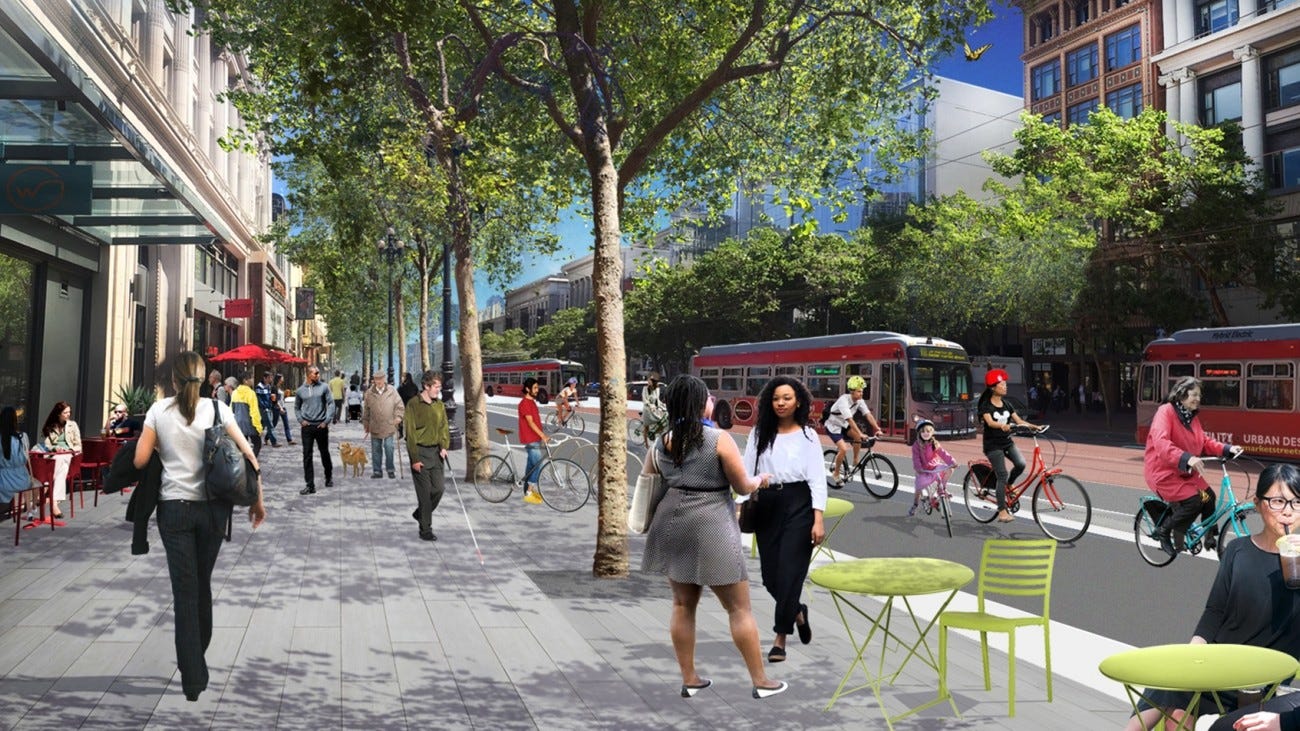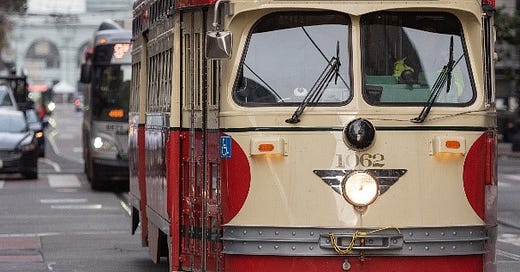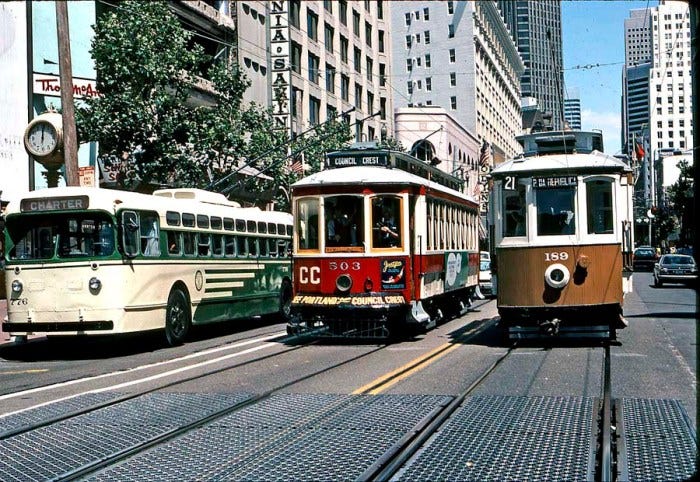The F Line Streetcar
A metaphor for San Francisco's rich history of adaptability, resilience, and poor budget planning
Next to the clanging cable cars on travel vlogs and postcards, the F line streetcars are the true unsung hero of San Francisco tourism.
With their history of private and public sector competition, adaptability, and resilience, one could almost say they are a metaphor for the city itself. However, the brightly colored streetcars of the F Market & Wharves line also hide a history of poor prioritization and budget allocation, driven by profit and political agendas.
Context
The F Market & Wharves light rail service winds its way through bustling Market and Embarcadero streets, starting from Fisherman's Wharf and ending in The Castro District. Each car stops a total of thirty times along the way, with 20 minutes of headway in between. The line operates from 6 AM to 10 PM on weekdays, with extended hours on weekends, making it perfect for tourists hoping to explore the city in cute, vintage vehicles.
A Brief History
As a part of San Francisco’s heritage street car service, the F Market & Wharves line holds a lot of historical significance.
Rail transit has been present on Market Street since 1860 in one form or another. Streetcars were electrified following the 1906 earthquake, and many of the streetcar lines created along Market Street in the early 1900s still serve San Francisco residents and visitors as bus routes today.
By the 1910s, most mass transit along Market Street had been privatized and was expensive. The Municipal Railway (more commonly known as Muni), a government-owned entity which operates the F-Market line today, was formed in 1912 as a response to the greedy private transit companies building San Francisco’s streetcar lines at the time. Muni also began operating on Market Street, creating multiple competing lines on similar routes and significantly increasing transportation options in downtown San Francisco. Soon, Muni went on to open streetcar routes in various other locations, creating affordable street car travel options in neighborhoods such as North Beach, Russian Hill, and the Presidio.
While Muni retired old streetcars or invested in renovating them, the emergence of BART in the 1970s and early 1980s resulted in the removal of surface light rail from downtown San Francisco.
However, San Francisco residents never stopped demanding surface streetcar service to be brought back on Market and Embarcadero. At first, the local government was unsure whether this would be a successful venture. However, the ridership increase experienced by vintage streetcars during cable cars repair periods de-risked the prospect and allowed for the line to be temporarily re-opened.
The F-Market line streetcars made their debut at the San Francisco Trolley Festival, proving to be a resounding success, particularly among tourists. This led to the F-line becoming a permanent transportation route in the 1990s, solidifying vintage streetcars as a cherished aspect of San Francisco's transportation landscape.
Personal Analysis on the Current State of the F Line:
Based on my personal experiences, there are a few glaring problems with the F-Market line and Muni as a whole:
Speed and delays: The streetcars are very slow and result in significant delays that build up over the day. Furthermore, there is also friction and confusion amongst riders when entering and paying fares, only increasing delays.
Route Congestion: The F-Market line is heavily crowded and also shares space with other, private and public transportation vehicles. This causes congestion and slower travel times. This is exacerbated during times with heavy traffic or during events that attract large crowds.
Limited Frequency: While the online schedule aims for a streetcar arriving every twenty minutes, the frequency of F-Market streetcars might not be as high as desired, especially during off-peak hours. This can result in longer wait times for passengers, which is especially frustrating if they are trying to make connections to other parts of the city.
Accessibility: Some of the historic streetcars used on the F-Market line do not have accessible features for individuals with mobility challenges. Although efforts have been made to introduce accessible streetcars into the fleet, the availability of these accessible vehicles can still be limited.
These issues seem to be attributed to the fact that the San Francisco Municipal Transportation Agency (SFMTA) and Public Works Department struggle with prioritization and budgeting, and often tend to prioritize the needs of wealthy tourists over the interests of locals (particularly low income commuters). In fact, even after receiving $15 million in federal funding for the Better Market Street Project, which aimed to resolve pedestrian and rail safety issues by eradicating cars from Market Street, SFMTA’s lack of prioritization and planning skills led to them indefinitely delaying important deadlines. The city was forced to return all $15 million of the grant, becoming yet another embarrassing failure in the path to revitalizing Bay Area transportation and infrastructure post-pandemic. The plan has been significantly reined in to avoid costly repairs, leaving sewer lines in poor condition and unprotected bike lanes the way they currently are.

It becomes clear when analyzing the history and current decisions of the city officials in regards to the Muni that local communities were almost never the priority - transportation in San Francisco, particularly in downtown San Francisco, has come to symbolize the city and is therefore a major tourist attraction. Despite being government controlled nowadays, profits still drive a majority of the decisions made by the SFMTA, including the decision to bring back the F Market & Wharves streetcar line.
Concluding Thoughts
The F Market & Wharves line faces a multitude of challenges in its path forward. Similar issues of inequality can be observed in the East Bay, where certain transportation improvements primarily benefit affluent suburban residents while neglecting bus services.
This narrative is unfortunately woven into the fabric of San Francisco. As a techie myself, it is important to recognize my role as a transplant. I live in a city that has insanely inflated cost of living due to tech companies moving here, creating problems that have had lasting, negative effects exacerbated by the pandemic. As the city itself starts to lose business to the suburbs, we see history repeating itself as wealthier residents flee to the suburbs. These issues are creating even more hurdles in the path towards more equitable, resident-friendly infrastructure.
To create a more equitable transportation system, it is essential for decision-makers to prioritize the needs of all residents, improve service efficiency, and address accessibility concerns to ensure that transportation reliably serves the communities it is meant to serve, first and foremost. It is the only way to bring restore the former glory of SF’s streetcars, cementing their symbolic value rather than further tainting it.






